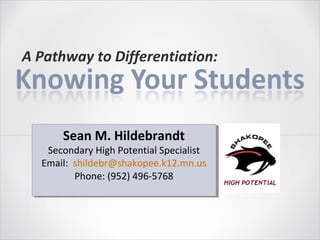Knowing Your Students
•
3 likes•2,938 views
This slideshow is intended for teachers who are motivated to explore with, implement, or advance aspects of differentiated instruction. The aspect we focus on here is student learner profiles.
Report
Share
Report
Share

Recommended
Presentation on effective teaching

Presentation on effective teachingJaved Iqbal Student of M.S (Teacher Education) at University of Tennessee USA
Recommended
Presentation on effective teaching

Presentation on effective teachingJaved Iqbal Student of M.S (Teacher Education) at University of Tennessee USA
More Related Content
What's hot
What's hot (20)
Introduction To Dealing With Difficult, Defiant And Unmotivated Students Adams

Introduction To Dealing With Difficult, Defiant And Unmotivated Students Adams
Similar to Knowing Your Students
Similar to Knowing Your Students (20)
Multiple intelligences: Understanding Your Students

Multiple intelligences: Understanding Your Students
PowerPoint Presentation 1: Overview of Learning Theories

PowerPoint Presentation 1: Overview of Learning Theories
An Investigation Into The Relationship Between EFL Teachers And Students Mu...

An Investigation Into The Relationship Between EFL Teachers And Students Mu...
Andragogy – Malcolm Knowles 1 Andragogy Malcolm Knowle.docx

Andragogy – Malcolm Knowles 1 Andragogy Malcolm Knowle.docx
More from Shakopee Public Schools
More from Shakopee Public Schools (20)
Recently uploaded
This slide is prepared for master's students (MIFB & MIBS) UUM. May it be useful to all.Chapter 3 - Islamic Banking Products and Services.pptx

Chapter 3 - Islamic Banking Products and Services.pptxMohd Adib Abd Muin, Senior Lecturer at Universiti Utara Malaysia
https://app.box.com/s/tkvuef7ygq0mecwlj72eucr4g9d3ljcs50 ĐỀ LUYỆN THI IOE LỚP 9 - NĂM HỌC 2022-2023 (CÓ LINK HÌNH, FILE AUDIO VÀ ĐÁ...

50 ĐỀ LUYỆN THI IOE LỚP 9 - NĂM HỌC 2022-2023 (CÓ LINK HÌNH, FILE AUDIO VÀ ĐÁ...Nguyen Thanh Tu Collection
Recently uploaded (20)
Basic Civil Engineering Notes of Chapter-6, Topic- Ecosystem, Biodiversity G...

Basic Civil Engineering Notes of Chapter-6, Topic- Ecosystem, Biodiversity G...
The Art Pastor's Guide to Sabbath | Steve Thomason

The Art Pastor's Guide to Sabbath | Steve Thomason
Solid waste management & Types of Basic civil Engineering notes by DJ Sir.pptx

Solid waste management & Types of Basic civil Engineering notes by DJ Sir.pptx
Chapter 3 - Islamic Banking Products and Services.pptx

Chapter 3 - Islamic Banking Products and Services.pptx
Home assignment II on Spectroscopy 2024 Answers.pdf

Home assignment II on Spectroscopy 2024 Answers.pdf
MARUTI SUZUKI- A Successful Joint Venture in India.pptx

MARUTI SUZUKI- A Successful Joint Venture in India.pptx
Matatag-Curriculum and the 21st Century Skills Presentation.pptx

Matatag-Curriculum and the 21st Century Skills Presentation.pptx
aaaaaaaaaaaaaaaaaaaaaaaaaaaaaaaaaaaaaaaaaaaaaaaaaaaaaaa

aaaaaaaaaaaaaaaaaaaaaaaaaaaaaaaaaaaaaaaaaaaaaaaaaaaaaaa
50 ĐỀ LUYỆN THI IOE LỚP 9 - NĂM HỌC 2022-2023 (CÓ LINK HÌNH, FILE AUDIO VÀ ĐÁ...

50 ĐỀ LUYỆN THI IOE LỚP 9 - NĂM HỌC 2022-2023 (CÓ LINK HÌNH, FILE AUDIO VÀ ĐÁ...
Benefits and Challenges of Using Open Educational Resources

Benefits and Challenges of Using Open Educational Resources
Industrial Training Report- AKTU Industrial Training Report

Industrial Training Report- AKTU Industrial Training Report
Welcome to TechSoup New Member Orientation and Q&A (May 2024).pdf

Welcome to TechSoup New Member Orientation and Q&A (May 2024).pdf
How libraries can support authors with open access requirements for UKRI fund...

How libraries can support authors with open access requirements for UKRI fund...
Knowing Your Students
- 1. A Pathway to Differentiation: Sean M. Hildebrandt Sean M. Hildebrandt Secondary High Potential Specialist Secondary High Potential Specialist Email: shildebr@shakopee.k12.mn.us Email: shildebr@shakopee.k12.mn.us Phone: (952) 496-5768 Phone: (952) 496-5768
- 2. Differentiation is a teacher’s response to learner needs shaped by mindset and guided by general principles. Teachers can differentiate through content, process, or product according to students’ readiness, interest, or learning profile. - Carol Ann Tomlinson (1999)
- 3. Teachers strategically use varying forms of student groupings to target particular needs while observing the students in a wide range of settings. Depending on the lesson objective, groupings are primarily based on: Readiness – assessed ability levels Interests – compiled from tailored surveys Learning Preference – instrument driven
- 4. Each student has a unique set of learning abilities and preferences. Collectively we can refer to this data set as a Learner Profile. The profiles are often composed of four parts: Individual Aptitudes Multiple Intelligences Personal Interests Learning Styles
- 5. Students already come to us with normed aptitudes. These scores include, but are not limited, to: MAPs MCAs CogAT Explore PLAN
- 6. Howard Gardner defined seven unique intelligences in his 1983 book Frames of Mind: The Theory of Multiple intelligences. He later added an eighth and may add more (Gardner, 2003). Differentiating instruction with MI in mind triggers deeper understanding for more students (Brualdi, 1996). Have students identify their own strengths. Bodily-Kinesthetic, Intrapersonal, Interpersonal, Linguistic, Musical, Logical-Math, Naturalist, & Spatial
- 7. Research suggests that high student interest: Significantly activates the putamen in the brain (Johnson & Becker, 2010) Leads to greater attention (Engelmann & Pessoa, 2007) Greater willingness to learn (Raymond, 2009, et. al.) Leads to greater persistence (Vanstennkistee, Simons, Lens, Sheldon, & Deci, 2004)
- 9. The classic three learning preferences: Visual, Auditory, & Tactile Many variants of learning style inventories exist: Kolb, McCarthy, Dunn Two of the more extensively referenced instruments were developed by Myers – Briggs and Gregorc.
- 10. Anthony Gregorc created a self assessment tool that categorizes adults into one of four Mind Styles
- 11. Katherine Briggs and her daughter, Isabel Briggs Myers, studied the work of psychologist Carl Jung and developed a psychometric questionnaire to categorize how people perceive the world.
- 12. Ideally, teachers compile the data points into an easily referenced and customized tool…. Use the learner profiles of the class to guide differentiation Build project lists and project menus that play to the students strengths Group students together based on learner profiles
